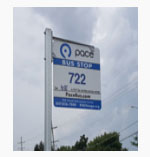Flag stop operation
Right now on some Pace routes, passengers can board or alight the bus at any intersection along the route where the driver deems it is safe to do so. Passengers are encouraged to wait for the bus at bus stop signs, but it is not mandatory that they do so. However, Pace had been undertaking a project to change that policy, in which we were working to convert all bus routes to posted-stops-only operation.
Posted-Stops-Only operation
Most Pace routes have been converted to a posted-stops-only operation, which means that passengers can board or alight the bus only at posted Pace bus stop signs or Pulse stations. Pace believes this operation to be easier for drivers and passengers to understand, more reliable and enables shorter travel times for customers. Most routes in the Pace network will eventually be converted to this type of operation. The list of routes already converted is below.
During detour operations, the temporary route segment will—unless otherwise noted—operate under the "flag stop" policy, meaning passengers can board or alight the bus at any intersection along the route where the driver deems it is safe to do so. Only in cases of long-term detours will the lists of stop locations (linked in the table below) be updated to reflect stop locations along detour segments.
Bus Stop Appeal Forms
If stakeholders in the Pace region have a concern about a bus stop (or lack of a bus stop) in any particular location, they can fill out a Bus Stop Appeal Form. These requests are processed by Pace staff, including a site visit, and requesters will receive a response within 3 weeks.
If you are requesting to have a bus route's geographic routing changed, please email Pace Customer Relations Department rather than making that request in a Bus Stop Appeal.
Printed schedule notations
Look for these notations on the printed schedule:


